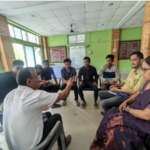Anupa Lahkar Goswami highlights here the utmost need to find ways and formulate effective measures to increase the number of observation homes for the increasing number of juvenile delinquents and questions the urgency and necessity to try a minor above 16 years in an adult court.
Ahmed, a 16 year old boy lives a carefree life in the dirty pavement of the Guwahati railway station. Orphaned at the age of 10, he is free willed, fun loving and aspires to be Bollywood heartthrob Salman Khan. He (name changed) picks rags by day and takes recluse in substance abuse by night.
Having seen a couple of flicks with his friends in the nearby slums, he was inspired by the blockbuster conman movies and considered that stealing from unsuspecting people was fun. Driven by the adrenaline of adventure he tried his hands at petty crimes a number of times deriving pleasure from the small catches until January 2013, where he was caught red handed by the Government Railway Police (GRP) personnel and handed over to the local thana.
Ahmed then had to undergo a hell like journey of being handed over from one authority to the other until having found a place at an observatory home in the state. For him his misadventure had come to a grinding halt and now he was juggled from shelter homes to stations trying to find what the authorities like to call remand homes.
For young boys like Ahmed, petty crimes have led to an entire turn of events where observation homes could possibly change their course of life. But the very little time left in these observation homes after being shuttled from one hand to another, leaves very little scope for reform. While sadly sometimes these young ones are beaten or badly bruised by police in the jails leaving them vindictive and lost for direction.
The national debate on Juvenile Justice Act which erupted in volcanic proportions after the heinous rape of Nirbhaya, where the Juvenile was found to have behaved in the most barbaric manner, the state of Assam also witnessed a sporadic increase in the rate of Juvenile crimes. Assam topped in juvenile delinquency among the North-eastern states in 2011 with 405 cases, according to the National Crime Record Bureau (NCRB).
They say “spare the rod and spoil the child” but the new adage that is making the rounds is that “spare the law and spoil the society”. With little substantive debate on the adequacy of the Juvenile Justice Act to deal with such heinous crimes, people across are contesting on whether the age for juvenile delinquency should come down or not.
Despite the debate on minimising the age for juvenile crimes, the presence of the two observation homes in Assam is not sufficient for the increasing number of Juveniles deserving a second chance to take off from the clutches of conflict with the administration.
Sharing his experiences in handling Juvenile criminals, a senior GRP officer posted at the Guwahati Railway Station said, “these young boys who invariably remain high on substance abusive materials like dendrites are now attacking passengers and staff of the railway if they are not provided with money they beg for”. He further said, “It is a common phenomenon that they will beg before you for money saying that he or she has not taken meal for days and if you refuse they will attack you with sharp blades without giving you much time to react,” said the officer who did not wish to be named.
These incidents teamed up with heinous crimes, leaves the authorities with a startling number of children in conflict with law with very little scope for reforms.
The recent Regional Round Table Conference of North Eastern States and Sikkim on Effective Implementation of Juvenile Justice (Care and Protection of Children) Act, 2000 came up with some startling loopholes and recommendation for the upliftment of the Juvenile Justice Act.
Mr. Justice Madan B. Lokur, Judge, Supreme Court of India, representing the Supreme Court Committee on Juvenile Justice said, “Nearly 40 per cent of the population in this country is below the age of 18 years and hence fall within the purview of the Juvenile Justice Act. The time has come to question ourselves as to what is being done for these children and review and find out as to what could be really done.” He added that the identification for these loopholes and their long term solution is a must in representing these youths and making the future hopeful for them.
However, despite the steady increase of crime rates amongst the minors, Assam has only three children homes and four observation homes run by the Social Welfare Department covering all the districts of the state. These observation homes are housed by orphaned children and juveniles, who were once involved in petty crimes.
“Despite the long pending demand of the human rights bodies and child welfare committees for the setting up of more children and observation homes in the State, the progress of the Social Welfare Department in this area is rather snail paced and lack any firm conviction,” stated a member of the Child Welfare Committee in Guwahati.
It may be mentioned that an observation home in Jorhat, set up in 1987, has to look after 11 districts in upper and central Assam and some of the major conflict zones are not even looked after properly.
Dr. Tushar Rane, Chief, UNICEF, Assam Field Office, speaking at the two day conference, stressed on the need of the Government support and all key stakeholders in building strong service delivery structures and monitoring mechanisms under JJ Act.
What could possibly lead to a better mechanism in this sector in addressing the needs of these children in need of attention and systematic counseling which they lack at home? Many are products of dysfunctional families while some of substance abuse. Simply decreasing the age is unlikely to minimise the crime rate. A broader mechanism has to be formulated for laying a strong foundation for the redressal of these issues and the presence of sufficient reform homes like those of America and United Kingdom is the strong need of the hour.
What is under the purview of the current Juvenile Justice Act?
- Passed in 2000 with the purpose of incorporating into domestic law India’s obligations under international law as a signatory of the U.N. Convention on the Rights of the Child of 1989, the U.N. Standard Minimum Rules for Administration of Juvenile Justice (1985) (known as the (“Beijing Rules”) and the U.N. Rules for the Protection of Juveniles Deprived of their Liberty (1990).
- It is based on the principle that juveniles lack the physical and mental maturity to take responsibility for their crimes in which their character is largely in the process of formation and prospects are available for their rehabilitation and upliftment.
- The JJA leads to the creation of a system where the persons up to the age of 18 in conflict with the law or committing punishable offence are not subject to the stringent adult laws or imprisonment rather they are subject to advice/admonition, counseling, community service, payment of a fine or, at the most, be sent to a remand home for three years.
The debate concerning the age revision
- Debates are on for trying offenders above 16 years of age to be tried under stringent sections of rape, murder and narcotics with regular criminals.
- Child activists believe that the new act will be against children and will not benefit them either ways and most crimes are committed due to impulse and under the influence of adults.
- Stress on reformative than punitive laws with more emphasis on their rehabilitation and reformative homes.
- Adults influencing and inciting adolescents to commit heinous crimes should be severely dealt with.
- If Juvenile age is lowered, why not the age of adulthood as in right to marry, vote or own property.
All said and done, the ball now remains in the court of Juvenile Justice Board, who now have to decide whether the amendments to this law passed by the Cabinet, brings about a positive change or shows India before the eyes of the world – a dirty picture.






